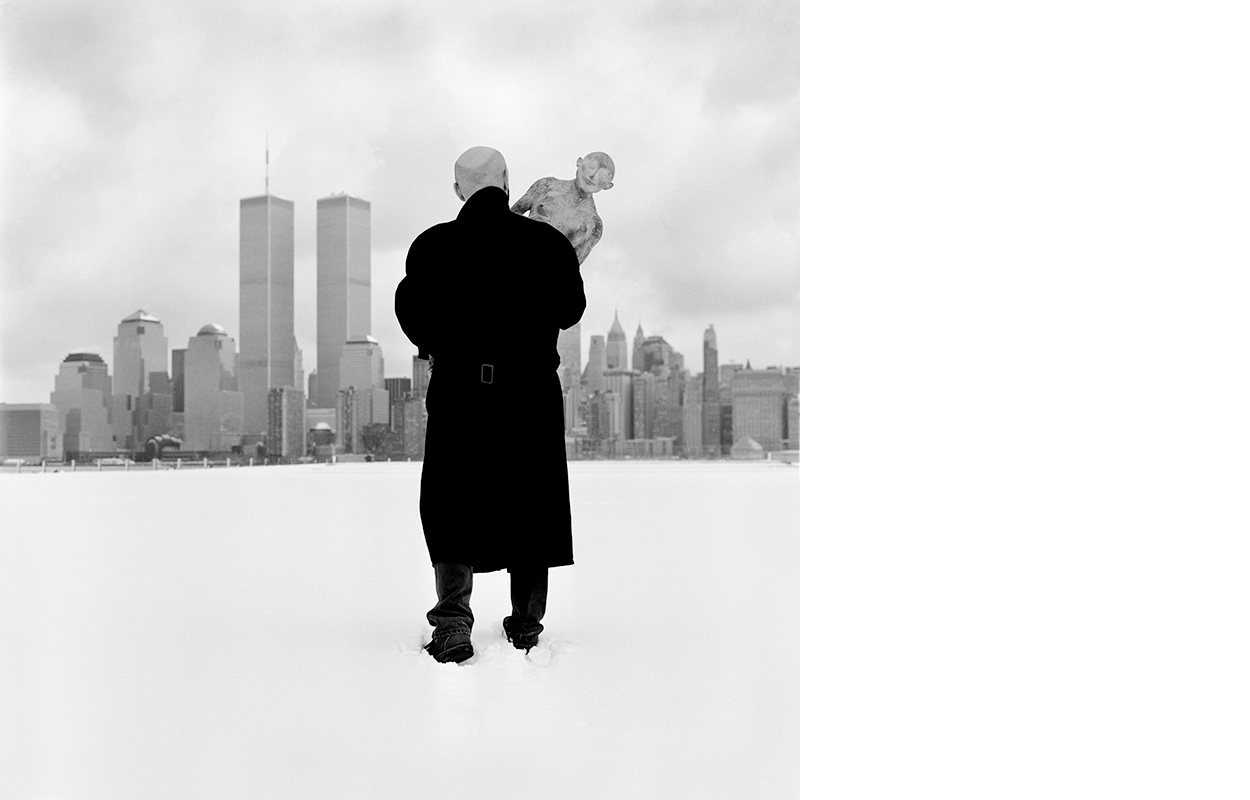Vladimir Kanevsky makes whimsical, figurative sculptures that charm the viewer with intuitively appealing, if highly improbable, narratives. His ceramic, small-people seduce us with round bellies, bald heads and sweet smiles. Upon first sight we understand that their simplified worldview is no match for the far more complex world we viewers inhabit. We are enticed both into good humor and to feel protective of these amiable folk.
Vladimir, a Ukrainian, grew up in the USSR and immigrated to the New York City area as a young man. We met through the gallery that represented us both. He was expanding his reach as a sculptor, and I was making my first impact as a New York City photographer. Vladimir agreed to my making his portrait.
It so happens that it snowed only once during the entire winter of 1997-1998. That storm fell during the morning of our scheduled photography session. Upon our arriving at his studio, Vladimir warmed my assistant and me with strong, Russian coffee. Sitting at his kitchen table, we found similarities in our aspirations – his as an artist, mine as a New York City photographer. Then we moved on to make small number of interior portraits. At some point we looked out a window and realized the obvious: how could we not photograph this Ukrainian in the snow?
My assistant and I packed up our equipment, Vladimir hoisted an agreeable sculpture off of its base, and we four squeezed into my Toyota Corolla. We drove to Liberty State Park, just across the Hudson River from lower Manhattan. The park was nearly deserted. Off to the side we heard gleeful laughter as children lobbed snowballs with their father.
Yet what caught our attention lay at our feet and extended to the river’s edge. It was a field of pure, white, freshly fallen snow. From where we stood we could not see the river, so the ground spread like a welcoming blanket between us and the magnificent buildings on the other side.
New York City commanded the horizon as I had never seen it assert its presence before. It was huge, it was near, and it seemed exclusively ours.
We were careful to preserve the magical setting by judiciously placing each one of our footsteps. Fortunately, we needed only enter fifteen or twenty feet into the snowy field. Vladimir walked in first. I followed at a short distance. We felt so blessed that our conversation was punctuated with giggling and outright laughter. We spontaneously suggested potential vignettes to each other as I captured several alternatives on film.
 The strongest frame from this series is one of the most subtle on the contact sheet. In it, you don’t even see Vladimir’s face – although you do see the face of his sculpture. It is a highly benevolent photograph. It tells the story of an immigrant as well as that of an artist. It tells the story of an arrival. The destination, an Oz-like New York City, lies but a few, short steps away. It is a portrait of anticipation and a promising future.
The strongest frame from this series is one of the most subtle on the contact sheet. In it, you don’t even see Vladimir’s face – although you do see the face of his sculpture. It is a highly benevolent photograph. It tells the story of an immigrant as well as that of an artist. It tells the story of an arrival. The destination, an Oz-like New York City, lies but a few, short steps away. It is a portrait of anticipation and a promising future.
Of course, the World Trade Center Towers are also in this picture. For many people, the events that would later take place here cast a somber overlay upon their perception of our experience. Many people now perceive this photograph with a sense of heaviness and loss, but those emotions were nowhere to be found on that magical field. Yes, the events of 2001 were significant and merit a narrative of their own, but that story is separate from this one. That day, in 1997, we felt joyous. We were blessed. We photographed hope.

